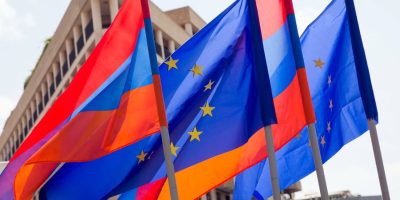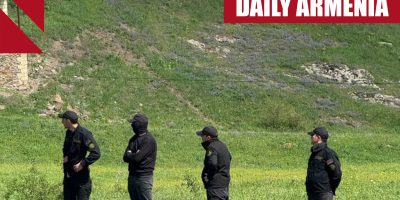 The Berlin Wall, a physical barrier that divided a city and a nation, came crashing down 25 years ago on November 9, 1989.
The Berlin Wall, a physical barrier that divided a city and a nation, came crashing down 25 years ago on November 9, 1989.
The Berlin Wall, a physical barrier that divided a city and a nation, came crashing down 25 years ago on November 9, 1989. The events leading to the fall had begun several months earlier in August when Hungary, buoyed by sweeping changes in the Soviet Union under Mikhail Gorbachev effectively opened its border crossing with Austria. By September, approximately 13,000 East German tourists in Hungary, used this chance to escape to Austria. Many more East Germans were prevented from crossing the Hungarian-Austrian border and were returned to Budapest where they went to the West German Embassy, refusing to return to East Germany. By the end of September, mass demonstrations began in East Germany eventually forcing Erich Honecker, the country’s head of state to resign on October 18, 1989.
On November 9, 1989, thousands of East Berliners went to the border crossings along the Wall. At Bornholmer Strasse, Berliners demanded that the border be opened. At 10:30 p.m. the border was opened and that is the moment which signalled the end of the Berlin Wall. The following weekend, ten new border crossings were opened as bulldozers broke the concrete barriers that had divided the city. Although the wall itself was not immediately brought down, in the days and weeks that followed, Berliners began chipping away at the wall, and eventually became known as the wall woodpeckers or the Mauerspechte.
Events in Berlin
A quarter of century after the fall of the Berlin Wall, a number of events and ceremonies are taking place in Germany. According to Deutsche Welle, some 2 million people are expected to gather in Berlin. A light installation marking a 15 kilometer stretch of a wall that divided the city was opened and earlier in the weekend some 7000 balloons were illuminated, which will be released into the dark night sky on Sunday.
German chancellor Angela Merkel, who was born in East Germany, during a podcast said, “I think you never forget how you felt that day – at least I will never forget it. I had to wait 35 years for that feeling of liberty. It changed my life.” Among the world leaders participating in the events are Mikhael Gorbachev, who will speak at the iconic Brandenburg Gate, former Polish President Lech Walesa, former Hungarian Prime Minister Mikos Nemeth and German President Joachim Gauck.
History of the Berlin Wall
With the end of the Second World War, the Potsdam Conference held between July 17 – August 2, 1945, which was meant to negotiate the terms for the end of the war, divided a defeated Germany into four zones. Each zone was occupied by the United States, France, Great Britain and the Soviet Union. The capital, Berlin, which was fully within the Soviet zone, was also subdivided into four sectors
The relationship between the Soviet Union and the three other Allied powers began fraying, and instead of an atmosphere of cooperation that was to have led to the eventual reunification of Germany, the occupation and division of Germany led to aggression. Finally, in 1949 the three zones occupied by the United States, France and Great Britain combined to form West Germany or the Federal Republic of Germany, and the zone occupied by the Soviet Union formed East Germany or the German Democratic Republic. Berlin suffered the same fate – it became for all intents and purposes, a city divided between East and West.
In 1955, the Soviets had given East Germany authority over civilian movement and the following year the East German state legally restricted all travel to the West. Toward the end of the 1950s, hundreds of thousands of East Germans unable to tolerate the repression by their authorities, began making their way to West Berlin. By 1961, the mass exodus had left East Germany in a precarious situation. Those who attempted to escape were straddled by heavy penalties. However, in the absence of a physical barrier, these measures were ineffective. By 1961, about 20 percent of the East German population had left. A decision was made to build a wall to prevent more people from crossing the fluid border.
On the night of August 12 and early morning hours of August 13, 1961, trucks carrying units of the East German army arrived and began tearing up streets running along the border to prevent crossings into West Germany. Barbed wire and fences were installed along the 156 km stretch of the three western sectors and 43 kilometers that divided East and West Berlin. Several days later, concrete blocks were set in place. Telephone wires between the two sides were also cut.
The concrete blocks were replaced by a concrete wall in 1965 and the final wall, built from 1975 to 1980 consisted of concrete slabs measuring 3.6 x 1.2 meters.
The Significance of the Fall of the Berlin Wall
While the Berlin Wall was built to prevent East Germans from escaping to West Germany, it also came to symbolize the potent political, social and economic ramifications of the Cold War – western capitalism versus communist totalitarianism. It was a physical monument of the Iron Curtain that separated the West from the Soviet Union. It tore apart families and divided a nation still reeling from a catastrophic defeat during the Second World War. The fall of the Berlin Wall symbolized a key turning point and the major downfall of many communist regimes. It also came to symbolize freedom from authoritarianism and repression. Today, 25 years later, the world remembers the fall of the Berlin Wall.
















